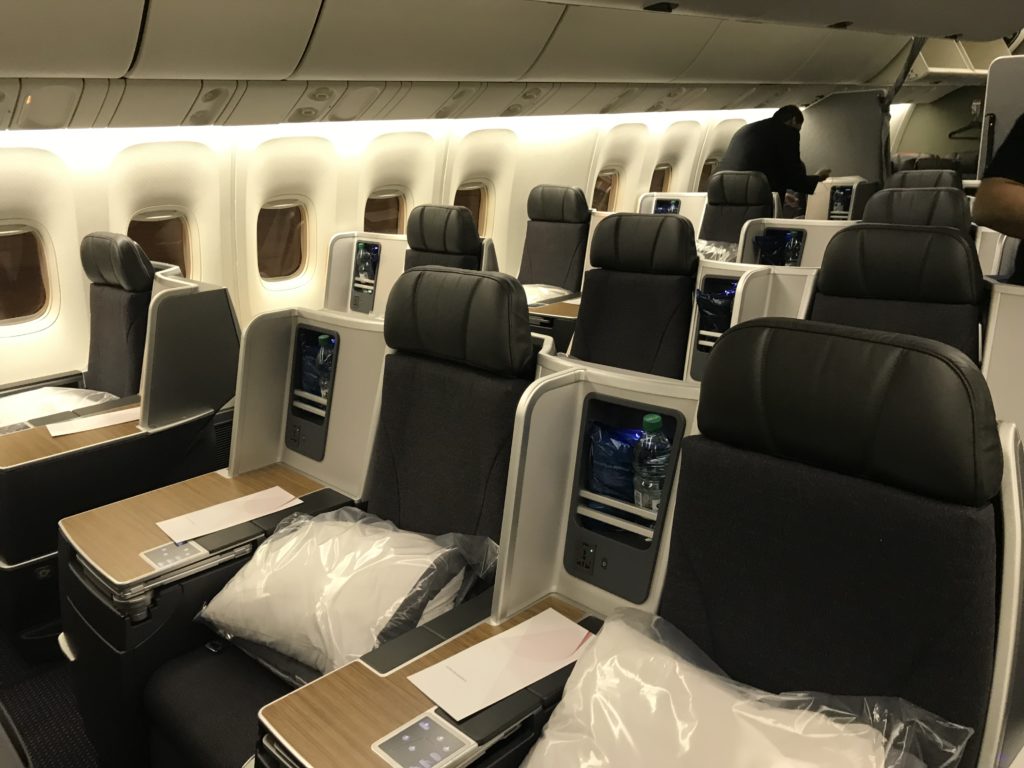Ever read about the insane value many travel bloggers get out of their miles? I’m talking crazy reports like 10 cents per mile (CPM) for premium first class travel. Running the numbers of miles used versus ticket cost, they aren’t wrong. Yet this doesn’t necessarily paint a fair picture of the value of award travel.
The other side of the coin is that there is a cap on the amount of cash I (and most reasonable people) would ever pay for a particular award flight or hotel stay. The actual cost is largely irrelevant. Sure, getting 10 CPM may sound amazing, but if you’d never pay $11,000 for a first class ticket, is this really reasonable? The value is the really getting to enjoy the experience.
Chuck over at Points with a Crew wrote a great piece comparing the two schools of thought when it comes to determining the value of an award redemption. This made me think about my own methods for calculating “value.” I definitely factor in the cash price of airfare, but my methods typically prevent me from coming up with overly inflated values for my awards.

How I Determine the Value of Award Travel
There is definitely a hard cap on the amount of money we can spend on any given trip. And it is fairly low. I cannot remember the last time that I planned a trip where we spent predominantly cash for flights, hotel, rental car, and activities. Most of the time, I try to use miles for flights and hotel, and cash for the rest.
Based on this, the metric of “what would I pay” for a particular award is entirely relevant. In many cases, what I would actually pay is rather small. Still, that’s not an entirely fair metric. If I’d only be willing to shell out $150 cash for a flight that costs $550, this would peg my CPM really low. The key for me is comparing what you’d burn in points to the cheapest similar itinerary. This goes for both flights and hotel.
I like to maximize the value of my award travel to ensure I am getting the best value for my points. Burning 8,000 Hyatt points for a Hyatt Place going for $90 per night isn’t an ideal redemption. Burning 8,000 Hyatt points for a hotel going for $150 per night is. But does the same hold true if the hotel next door is going for only $105? Which to I compare it to?
Over time I’ve found that there isn’t all that much difference in cost between hotels of the same quality, and comparing a Hyatt Place to a Travelodge down the road just isn’t fair. It became easiest to simply compare to the hotel itself. There are certainly times where a cash price is the best, and if the Travelodge is going for $50, there are reasons I may pick it. But I digress.
The method I use for determining the value of a hotel redemption is pretty straightforward. I divide the fully loaded rate (rate, taxes, and any fees, subtracting any fees I do pay) by the number of points I am using. This gives you the cents per point (CPP) value that you are getting.
I have a floor on the CPP I’m willing to receive with each particular currency (although I will make exceptions, if I really do not want to spend cash). If it’s above the baseline minimum value, I book the stay as an award. If it’s below, I use cash.

Determining the Value of Award Flights
Flights are an entirely different animal. Unlike hotels, where you can quickly and easily determine the CPP value, I like to take in the whole picture with flights. You can do the same with hotels, but as I mentioned, hotel prices versus amenities vary a lot, and comparing “out of class” properties isn’t necessarily fair.
With flights, I like to find the most ideal option that I would book with cash in the same class of service. This is the baseline price for my award redemption. This may or may not be the same itinerary I booked. For example, for our trip to South America, Delta was offering a better business class price than American. So I compared our flights versus that.
In some cases, I’ll add a bit to the cost or remove some flights from consideration if there are other reasons I would book a particular ticket and not another (i.e. nonstop flight, or a particular carrier). Adding to the previous example, COPA technically offered the best business class price. However, both segments would have been in 737 recliner business and the flight timing was awful. This isn’t an itinerary I would book.
In short, the key for determining flight value is determining what the lowest cost comparable itinerary is.
We could quibble over American’s lie-flat product versus Delta’s, but I generally don’t go that far. Both are U.S. carriers with decent business class products, and if I did have the cash to push around to book business class, I wouldn’t pay another $1,000 for American’s business class over Delta.
One-Way Versus Round-Trip Flights
In nearly all cases, I also determine the value based on the round-trip price. For most travel, I’m booking round-trip tickets, even though I may book the outbound as one award and the return as a second award. Honestly, I do this more often than not. Yet the round-trip cost is a better baseline for comparison. Why? Because the price for many carriers for one-way tickets is ridiculously inflated, often more than booking a round-trip.
For one-way awards, I base the value on half the cost of a round-trip. If the trip requires a stopover, I build that in as it’s own itinerary within an open-jaw primary itinerary, or find the value of the whole thing as a multi-city booking. If I truly do need a one-way ticket, I will sometimes compare against the one-way price. But typically I don’t.
Once I determine the lowest price comparable itinerary to the one I am booking (it may or may not be the exact flights I book), this is what I use to determine the value of the award. From here it is simple math. I take the cash cost of the comparable itinerary, dividing it in half for a one-way award or using it straight for a round-trip. Then I subtract out the award fees (i.e. the cash I do pay), and then divide the remaining cost by the number of miles used. This paints the most accurate picture of the real value I’m getting.

Some Examples Over the Past Couple Years
Here are some award redemption value examples from bookings I have made from 2017 through present:
- United economy one-way from ACV to TUS – 5.3 CPM (Avianca LifeMiles)
- China Airlines business class SFO to TPE – 2.2 CPM (Delta SkyMiles)
- Short SFO-ACV one-way hop – 2.4 CPM (Avianca LifeMiles)
- Finnair business class one-way from LAX to HEL – 3.9 CPM (American AAdvantage)
- Upcoming United economy one-way for my return from NOLA meetup – 4.9 CPM (United MileagePlus)
For the United one-way economy flight to Tucson, I used the round-trip price, even though I specifically needed a one-way in this case (it was the beginning of a fun little Southwest road trip with my older kids). In the case of the other short SFO-ACV hop, I used the one-way price since this is really what I needed.
For the China Airlines business class, I used half the cost of a round-trip award for the flight itself as a the value, since the nonstop price wasn’t bad and only marginally more than connecting options. For the other business class itinerary, I used half the cost comparable business class options.
The Real Value of Award Travel
Value in this hobby is pretty subjective. I’d rather be a bit more realistic about the value of an award redemption rather than crowing about how I got 8.3 CPM on a given award. Sure, the huge number sounds impressive when you compare against the exact cash cost of the particular flight. That being said, using LifeMiles and Turkish Miles & Smiles from my tiny regional airport has still yielded excellent value on even economy tickets.
But the question of “would I have used cash” still comes to mind. In many cases, I wouldn’t have paid for a flight at all. Why? Well, if we had to use cash for everything, we’d be traveling overseas maybe once per year and domestically only a couple more times. Without miles and pints, traveling as much as I do wouldn’t be possible.
The real value of award travel is getting to travel as much as we do. This is why I love miles and points. There are several trips that we simply never would have taken, except for the fact that I have miles to push around. Traveling to Australia for 5 days for ~$300? No way. Getting to visit China and Hong Kong for 10 days with my older two kids? Maybe in 3-4 years. Miles make the experiences happen, and I can never be too grateful for that.
Still, I still like to see the relative value I can get per mile, even if I will never book a business class ticket for cash. It’s a fun exercise, and it’s fun to see how I can maximize my points and miles. But at the end of the day, the best redemption is the one that gets you where you want to go, even if it isn’t the best “value” out there.
How do you determine the value of an award redemption?












A fair methodology. I wish some other bloggers would use it.